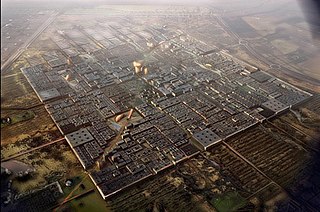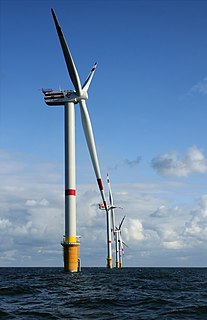
Electricity generation is the process of generating electric power from sources of primary energy. For electric utilities in the electric power industry, it is the first stage in the delivery of electricity to end users, the other stages being transmission, distribution, energy storage and recovery, using the pumped-storage method.

Energy storage is the capture of energy produced at one time for use at a later time. A device that stores energy is generally called an accumulator or battery. Energy comes in multiple forms including radiation, chemical, gravitational potential, electrical potential, electricity, elevated temperature, latent heat and kinetic. Energy storage involves converting energy from forms that are difficult to store to more conveniently or economically storable forms.

Renewable energy is energy that is collected from renewable resources, which are naturally replenished on a human timescale, such as sunlight, wind, rain, tides, waves, and geothermal heat. Renewable energy often provides energy in four important areas: electricity generation, air and water heating/cooling, transportation, and rural (off-grid) energy services.
Electric power systems consist of generation plants of different energy sources, transmission networks, and distribution lines. Each of these components can have environmental impacts at multiple stages of their development and use including in their construction, during the generation of electricity, and in their decommissioning and disposal. We can split these impacts into operational impacts and construction impacts. This page looks exclusively at the operational environmental impact of electricity generation. The page is organized by energy source and includes impacts such as water usage, emissions, local pollution, and wildlife displacement.

A zero-emissions vehicle, or ZEV, is a vehicle that emits no exhaust gas from the onboard source of power. Harmful pollutants to the health and the environment include particulates (soot), hydrocarbons, carbon monoxide, ozone, lead, and various oxides of nitrogen. Although not considered emission pollutants by the original California Air Resources Board (CARB) or U.S. Environmental Protection Agency (EPA) definitions, the most recent common use of the term also includes volatile organic compounds, several air toxics, and global pollutants such as carbon dioxide and other greenhouse gases.

Sustainable energy is a principle in which human use of energy "meets the needs of the present without compromising the ability of future generations to meet their own needs." Sustainable energy strategies generally have two pillars: cleaner methods of producing energy and energy conservation.

Grid energy storage is a collection of methods used to store electrical energy on a large scale within an electrical power grid. Electrical energy is stored during times when production exceeds consumption, and returned to the grid when production falls below consumption.
Stirling Energy Systems is a Scottsdale, Arizona-based company which developed equipment for utility-scale renewable energy power plants and distributed electrical generating systems using parabolic dish and stirling engine technology, touted as the highest efficiency solar technology.

The AES Corporation is a Fortune 500 company that generates and distributes electrical power. AES is headquartered in Arlington, Virginia, and is one of the world's leading power companies, generating and distributing electric power in 15 countries and employing 10,500 people worldwide.

Renewable energy commercialization involves the deployment of three generations of renewable energy technologies dating back more than 100 years. First-generation technologies, which are already mature and economically competitive, include biomass, hydroelectricity, geothermal power and heat. Second-generation technologies are market-ready and are being deployed at the present time; they include solar heating, photovoltaics, wind power, solar thermal power stations, and modern forms of bioenergy. Third-generation technologies require continued R&D efforts in order to make large contributions on a global scale and include advanced biomass gasification, hot-dry-rock geothermal power, and ocean energy. As of 2012, renewable energy accounts for about half of new nameplate electrical capacity installed and costs are continuing to fall.

As of 2018, renewable energy accounted for 79% of the domestically produced electricity used in Brazil.

Renewable energy accounted for 12.2 % of total primary energy consumption and 14.94 % of the domestically produced electricity in the United States in 2016. Hydroelectric power is currently the largest producer of renewable electricity in the country, generating around 6.5% of the nation's total electricity in 2016 as well as 45.71% of the total renewable electricity generation. The United States is the fourth largest producer of hydroelectricity in the world after China, Canada and Brazil.

Masdar City is a planned city project in Abu Dhabi, in the United Arab Emirates. Its core is being built by Masdar, a subsidiary of Mubadala Development Company, with the majority of seed capital provided by the Government of Abu Dhabi. Designed by the British architectural firm Foster and Partners, the city relies on solar energy and other renewable energy sources. Masdar City is being constructed 17 kilometres (11 mi) east-south-east of the city of Abu Dhabi, beside Abu Dhabi International Airport.

A solar car is a solar vehicle used for land transport. Solar cars usually run on only power from the sun, although some models will supplement that power using a battery, or use solar panels to recharge batteries or run auxiliary systems for a car that mainly uses battery power.
The distinct ways of electricity generation can incur significantly different costs. Calculations of these costs can be made at the point of connection to a load or to the electricity grid. The cost is typically given per kilowatt-hour or megawatt-hour. It includes the initial capital, discount rate, as well as the costs of continuous operation, fuel, and maintenance. This type of calculation assists policymakers, researchers and others to guide discussions and decision making.
Renewable energy is generally defined as energy that comes from resources which are naturally replenished on a human timescale, such as sunlight, wind, rain, tides, waves, and geothermal heat. Renewable energy replaces conventional fuels in four distinct areas: electricity generation, air and water heating/cooling, motor fuels, and rural (off-grid) energy services. Based on REN21's 2014 report, renewables contributed 19 percent to our global energy consumption and 22 percent to our electricity generation in 2012 and 2013, respectively.

Variable renewable energy (VRE) is a renewable energy source that is non-dispatchable due to its fluctuating nature, like wind power and solar power, as opposed to a controllable renewable energy source such as hydroelectricity, or biomass, or a relatively constant source such as geothermal power or run-of-the-river hydroelectricity.
Solar power in North Dakota is a little-used resource. The state ranked 51st on installed solar power in the United States, with 220 kW of installed capacity. Solar on rooftops can provide 24.6% of all electricity used in North Dakota from 3,300 MW of solar panels. The most cost effective applications for solar panels is for pumping water at remote wells where solar panels can be installed for $800 vs. running power lines for $15,000/mile.













